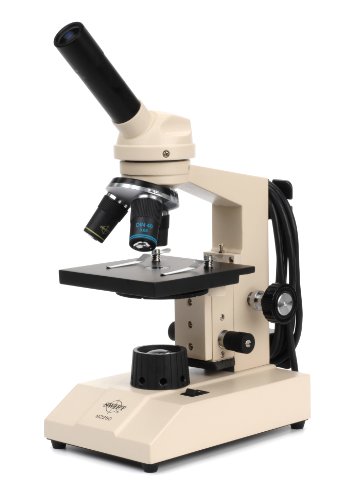The Swift Optical M2251B Basic Monocular Compound Microscope has a 10x widefield eyepiece with pointer, a forward-facing nosepiece with three DIN achromatic objectives that are parcentered and parfocal, tungsten illumination, separate coarse and fine focus, a 0.65 NA condenser with five-hole disc diaphragm, and a plain stage with stage clips. The monocular viewing head has a fixed inclination to reduce eye and neck strain, and 360-degree rotation capability to enable sharing. An eyepiece pointer is used to identify features for students. A forward-facing nosepiece eases changing objectives. Achromatic objectives provide color correction of magnified images. Parcentered and parfocal objectives ensure that the image stays centered and focused when the magnification is changed. The 40xR objective is retractable and spring-loaded to prevent damage to the slide or objective when focusing, and is sealed to protect against liquids and oils. A basic compound microscope is used in classroom, home school, and hobbyist settings for inspection and dissection of specimens when two-dimensional images are desired.
The microscope has lower (diascopic) Brightfield illumination that transmits light up through the specimen for enhanced visibility of translucent and transparent objects. Brightfield (BF) illumination allows the specimen to absorb light, resulting in a dark image on a light background. The tungsten (incandescent) light source provides bright light. A disc diaphragm controls the amount of light illuminating the specimen. The plain stage has an opening for light transmission, stage clips to secure the slide or specimen in place while viewing, and pre-drilled holes that accept a mechanical stage (sold separately). Separate coarse and fine focus knobs speed focusing. A slip clutch prevents excess pressure from damaging the slides or objectives, a stage stop prevents the stage or specimen from coming into contact with the objectives, and a focus tension control prevents stage drift.
| Microscope Head and Optics Specifications | |
|---|---|
| Head | Monocular |
| Magnification range | 40x-400x |
| Head inclination | 45 degrees |
| Eyepiece (18mm) | WF10x |
| Nosepiece | Forward-facing |
| Objectives, DIN achromatic, parcentered, parfocal | 4x, 10x, 40xR (sealed, retractable) |
| Microscope Illumination and Stage Specifications | |
|---|---|
| Focus type | Separate coarse and fine |
| Condenser | 0.65 NA |
| Light source | Tungsten, 20W |
| Diaphragm | Disc, five-hole |
| Illumination type | Brightfield |
| Stage type | Plain |
| Stage dimensions | 120 x 115mm (W x D) |
| Power | 110V |
W is width, the horizontal distance from left to right; D is depth, the horizontal distance from front to back.
Microscopes are instruments used to enhance the resolution of an object or image. Types include compound, stereo, or digital. Compound microscopes use a compound optical system with an objective lens and an eyepiece. Stereo microscopes show object depth in a three-dimensional image. Digital microscopes are used to display an image on a monitor, rather than looking through a lens. Microscopes can have monocular (one), binocular (two), or trinocular (three) eyepieces, with varying magnification abilities. Magnification ability refers to the size of an image. Resolution, also known as resolvant power, refers to the clarity of the image. The interaction between field of view (FOV), numerical aperture (NA), and working distance (WD) determines resolution. Microscopes can control magnification through a fixed focus, or through a range of adjustments. They can also utilize LED, fluorescent, and mirror light sources to help control viewing capabilities. Microscopes are widely used in education, lab research, biology, metallurgy, engineering, chemistry, manufacturing, and in the medical, forensic science, and veterinary industries.
Swift Optical Instruments manufactures microscopes and weather instruments. The company, founded in 1959, is headquartered in Schertz, TX.
What’s in the Box?
- Swift Optical M2251B Basic Monocular Compound Microscope WF10x eyepiece, 18mm
- 4x DIN achromatic objective
- 10x DIN achromatic objective
- 40xR (sealed, retractable) DIN achromatic objective
- Dust cover
- Instructions

